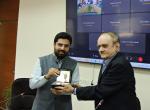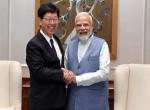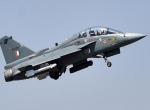Propelled by their enabling combat virtues like all-weather all-terrain operability, comprehensive mission spectrum, long ranges, tremendous endurance, precision strike capability and weapon loads that will give a run for their money to the combat platforms, the Unmanned Aerial Systems (UAS) have become powerful and versatile tools of combat. The net effectiveness of such vehicles continues to increase constantly because of niche technologies that are empowering these and providing enabling equipment for task completion. This brief work takes a look at some of these technologies and what equipment these provide for the 'UAS of the future'.
One niche area where technology is driving the enablement of the UAS is wireless communication solutions providing seamless connectivity between the UAS and the rest of the world. There was a time when a UAS, once launched on a mission, was simply a spatial extension of its Ground Control Station (GCS) to which it was slaved, and to which it sent audio and later audio video inputs on demand. As technology advanced, greater and greater autonomy started to get built into the UAS. This autonomy was defined as a measure of independence of the UAS platform from the GCS, leading to an end-state wherein the UAS platform, once launched, became nearly independent of the GCS for the conduct of its assigned mission.
Such an autonomy is being attempted to be achieved by building artificial intelligence (AI) suits on UAS platforms. Such suits, based on intelligent tools and neural networks, permit UAS to undertake many tasks independently. These could include maintaining a threshold surveillance activity and auto-reporting variations in default levels, picking up targets as forward scouts based on threat library data, carrying out auto-battle damage assessment and more. In joint missions involving manned and unmanned platforms, such AI tools help to reduce cockpit load of the pilot by letting UAS do most of the battle tasks on their own. Such UAS will require human intervention only as an exception, or when a manual override is necessary to avert an emergency.
As time unrolled, wireless connectivity through technological enablement took one more step forward in what is called the Common Data Link (CDL). Such a link is capable of providing a common bridge, thus threading a large number of dissimilar platforms on a seamless highway of data sharing. CDL is particularly useful when UAS operate with manned platforms or as a part of the large group of small drones called a ‘SWARM Network’.
The complex challenge of providing ever-increasing autonomy to UAS by the AI suits or multi-polar connectivity’s through CDL is being realised through a wide spectrum of embedded systems packaged to specific user requirements. The constituents of this package typically include field programmable gate array (FGPA) integrated chips (IC), multi-processor systems on chips (MPSoCs) providing capabilities of multimedia processing, telecommunication, and network security on a single substrate wafer element. All these electronic components cumulate to make up for a large array of micro-controllers, micro-processors, graphic processing units (GPU), and Wi-Fi modules miniaturised to be carried on board small UAS platforms. The end-to-end wireless communication and embedded system capability resides in-house either in stand alone or in technological partnerships (e.g., M/s Xilinx, Renseas Texas Instrumentation, and more).
Another niche area where the UAS are particularly useful and score way above the manned platforms is the area of carrying out 'radiation intelligence'. The obvious advantage of the unmanned system in this task lies in the fact of avoidance of human casualties or simply the incapability of inserting humans in hazardous and contaminated area to seek intelligence. Radiation intelligence by UAS, per se, is a vast field which includes a large number of activities, viz, monitoring and evaluation of a radiological situation, radiological mapping of radiation levels, measurement of surface densities of contamination, identification of radio nuclides etc. It may also include searching a lost source of radiation, control of transportation of radioactive substances over large distances, ensuring radiation safety in mass events or monitoring the consequences of nuclear accidents, and so on. Towards accomplishment of the huge task challenge as detailed above, technology is driving the wheel by providing three types of equipment verticals in the field of radiation intelligence. These include nuclear instrumentation, nuclear counting devices and radiation detectors.
Radiation detectors started their journey with the basic Geiger Muller (GM) Tube detectors, complete with accurate digital counting devices for detecting and measuring ionising radiations. As the technology advanced, greater sophistication entered the GM field in the form of end-window and wide end-window detectors of gamma rays. The next version of detectors were the GM Pancake Detectors which were not only inexpensive but also had the capability of detecting all three types of radiations, i.e. alpha, beta and gamma rays. Next in the series of detectors came the scintillating detectors which were based on the principle of luminescence. These detectors and probes, when excited by ionising radiations, emitted light which drove the associated instrumentation to measure the severity of radiation accurately.
Another technological challenge in the radiation intelligence field relates to detecting contamination while working with unsealed radioactive materials. Contamination may occur on the surface of the container or in the environment due to inadvertent leak of the radioactive material into the environment when a radioactive substance is being transported from one place to another. Sensitive detectors, probes and digital counting instruments are being made which are capable of such detection and which are adapted to use on UAS platforms.
In all the above the reassuring fact is that most of nuclear radiation UAS suits, comprising of state-of-the-art instrumentation, precision counting devices, detectors and probes, are being produced indigenously. Some frontline players in nuclear radiation instrumentation are M/s Nuclonix Systems India, M/s Nunes Instruments, M/s Anjali Incorporated etc.
The third area where the technology is driving the revolution is Lighter than Air (LTA) unmanned systems. LTA UAS are basically inflatable structures which are pressurised by filling gases in them that are lighter than air (like helium). Such UAS have the inherent capability to stay afloat in the atmosphere ( much like a gas-filled balloon). LTA UAS have many strengths. Firstly, the amount of energy required to keep them afloat is comparatively very less. Due to this, smaller, slower and quieter motors can be used in such UAS making them less noisy and far more stealthy. Such machines therefore become ideal for quiet and efficient hovering, slow forward movement and precision manoeuvres. Some of the later versions of LTA are also using morphing techniques of changing shapes and aspect ratio of its components for optimising its performance in flight . The latest LTA platforms have the dual capability of vertical take-off like a helicopter or conventional flight like a fixed wing aircraft. A lot of good research work on LTA is being done at IIT Mumbai.
In essence, riding on the enabling wings of technology, the unmanned revolution is on a high. The dimension of this growth is only limited by human imagination and little else.
(Views expressed are of the author and do not necessarily reflect the views of the VIF)
Image Source: https://www.reuters.com/article/us-usa-drone-hunter/drone-catchers-emerge-on-a-new-aerial-frontier-idUSKBN16S1IT









Post new comment